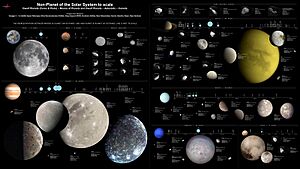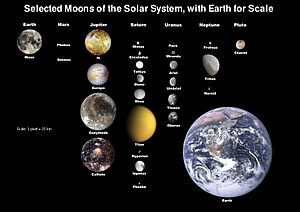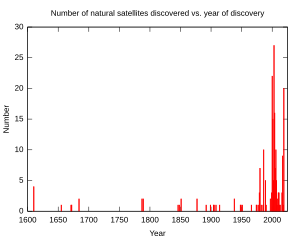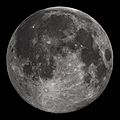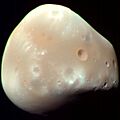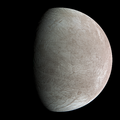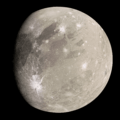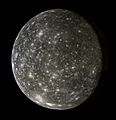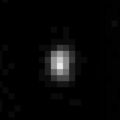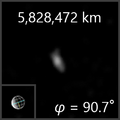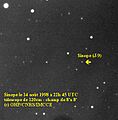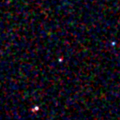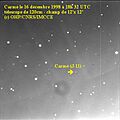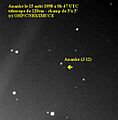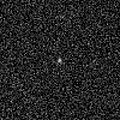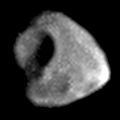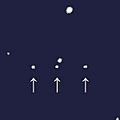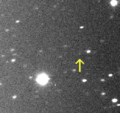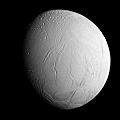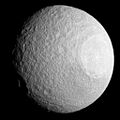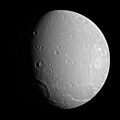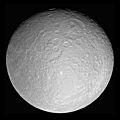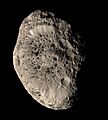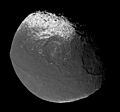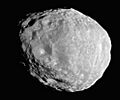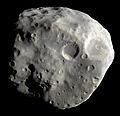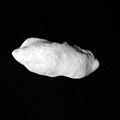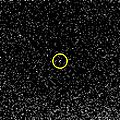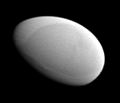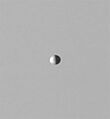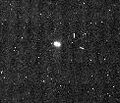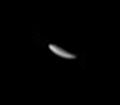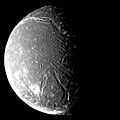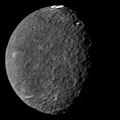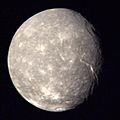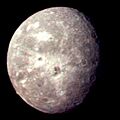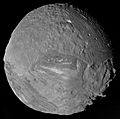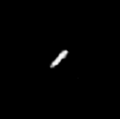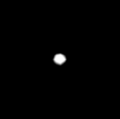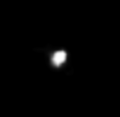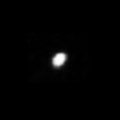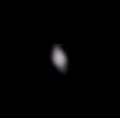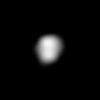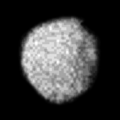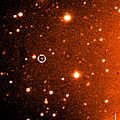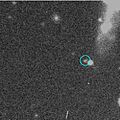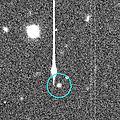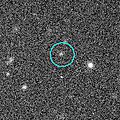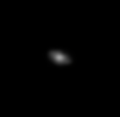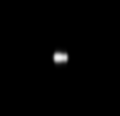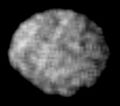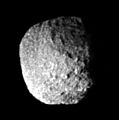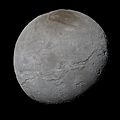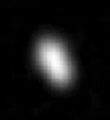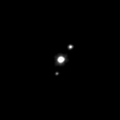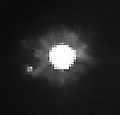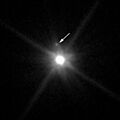List of natural satellites facts for kids
Our Solar System is home to eight planets and several dwarf planets. Six of these planets and six of the most likely dwarf planets have at least 299 known natural satellites, which we usually call moons!
About 19 of these moons are big enough to be round, just like planets. Most of these round moons are covered in ice, except for Earth's own Moon and Jupiter's moon, Io. Some of the very largest moons are so big that if they orbited the Sun directly instead of a planet, they would be considered dwarf planets or even planets themselves!
Moons are generally put into two groups based on how they orbit:
- Regular moons orbit in the same direction as their planet spins (this is called a prograde orbit). They also stay close to the planet's equator.
- Irregular moons can orbit in the same direction or the opposite direction (this is called a retrograde orbit). Their paths are often tilted at strange angles compared to their planet's equator. Scientists think irregular moons are probably small space rocks that got caught by a planet's gravity. Most irregular moons are smaller than 10 kilometers (about 6 miles) across.
The first moons discovered besides Earth's Moon were found by Galileo Galilei in 1610. He saw four moons orbiting Jupiter, which are now called the Galilean moons. For a long time, only a few more moons were found. But in the 1970s, space missions like Voyager 1 and 2 helped us find many more. Since the year 2000, large telescopes on Earth have discovered even more moons, and almost all of these new ones are irregular moons.
Contents
Moons of the Planets
Mercury and Venus
Mercury, the smallest planet and the closest to the Sun, doesn't have any known moons. If it did, they would have to be smaller than about 1.6 kilometers (1 mile) across for us not to have seen them yet. For a short time in 1974, people thought Mercury might have a moon, but it turned out to be a mistake.
Venus also has no moons. Even though there were stories about a moon around Venus way back in the 1600s, none have ever been found.
Earth
Earth has one Moon, which is the biggest moon of any rocky planet in our Solar System. Earth also has more than 20 known objects that share its orbit, like the asteroids 3753 Cruithne and 469219 Kamoʻoalewa. Sometimes, a space rock might temporarily orbit Earth, like 2020 CD3. However, because these don't orbit Earth permanently, they are not considered true moons.
Mars
Mars has two known moons, named Phobos and Deimos. These names mean "fear" and "dread," after the helpers of Ares, the Greek god of war (who is like the Roman god Mars). Scientists have looked for more moons around Mars but haven't found any. Any other moons would have to be smaller than about 90 meters (98 yards) across.
Jupiter
Jupiter has 95 moons with known orbits! 72 of them have official names. Jupiter's eight regular moons include the four large, planet-sized Galilean moons (Io, Europa, Ganymede, and Callisto) and the much smaller Amalthea group. These moons are named after lovers of Zeus, the Greek god who is like Jupiter.
Ganymede is the largest and most massive moon in the entire Solar System! Jupiter's 87 known irregular moons are divided into groups based on their orbits, like the Himalia group (prograde) and the Carme, Ananke, and Pasiphae groups (retrograde).
Saturn
Saturn has an amazing 146 moons with known orbits! 66 of them have official names. Most of Saturn's moons are quite small. Seven of them are large enough to be round, including Titan, which is the second largest moon in the Solar System.
24 of Saturn's moons are regular moons, and they are usually named after Titans or other figures connected to the Roman god Saturn. The other 122 moons are irregular. They are grouped by their orbits into the Inuit, Norse, and Gallic groups, and their names come from those mythologies.
Saturn's famous rings of Saturn are made of countless icy objects, from tiny dust grains to hundreds of meters wide. Each of these objects orbits the planet on its own. This means it's hard to say exactly how many moons Saturn has, because there's no clear line between the tiny ring particles and the larger named moons. Scientists have found at least 150 "moonlets" (tiny moons) inside the rings because of how they disturb the ring material around them.
Uranus
Uranus has 28 known moons. Five of these are big enough to be round. 13 moons orbit inside Uranus's ring system, and there are ten more outer irregular moons. Unlike most planetary moons, which are named after ancient gods, all of Uranus's moons are named after characters from the plays of Shakespeare and the poem The ... of the Lock by Alexander Pope.
Neptune
Neptune has 16 known moons. The largest one, Triton, makes up more than 99.5 percent of all the mass orbiting Neptune! Triton is big enough to be round, but it has a unique feature for a large moon: a retrograde orbit (it orbits backward). This suggests that Triton might have been a dwarf planet that was captured by Neptune's gravity a long time ago. Neptune also has seven inner regular moons and eight outer irregular moons.
Moons of Dwarf Planets
Pluto
Pluto, a famous dwarf planet, has five moons. Its largest moon, Charon, is named after the ferryman who carried souls across the River Styx in mythology. Charon is more than half the size of Pluto itself! They are so close in size that they actually orbit a point in space *between* them, forming what's sometimes called a double-dwarf-planet. Pluto's four other moons, Nix, Hydra, Kerberos, and Styx, are much smaller and orbit around the Pluto–Charon system.
Other Dwarf Planets
- Ceres has no known moons. Scientists are pretty sure it doesn't have any moons larger than 1 kilometer (about 0.6 miles).
- Eris has one large moon called Dysnomia. It's hard to know its exact size, but one guess is that it's about 350 kilometers (217 miles) across.
- Haumea has two moons, Hiʻiaka and Namaka, which are about 195 kilometers (121 miles) and 100 kilometers (62 miles) in radius, respectively.
- Makemake has one moon, which was found in April 2016.
- Many other objects in the Kuiper belt and scattered disk might also be dwarf planets. For example, Quaoar, Gonggong, and Sedna are generally thought to be dwarf planets by astronomers. All of them except Sedna are known to have moons.
As of October 2022, 365 asteroid moons and 128 trans-Neptunian moons (which include those of Pluto and other dwarf planets) have been discovered.
Summary of Moons
Here's a quick look at the number of moons for each planet and dwarf planet:
| Planet | Mercury | Venus | Earth | Mars | Jupiter | Saturn | Uranus | Neptune |
|---|---|---|---|---|---|---|---|---|
| Number of moons | 0 | 0 | 1 | 2 | 95 | 146 | 28 | 16 |
| Consensus dwarf planets | Ceres | Pluto | Haumea | Quaoar | Makemake | Gonggong | Eris | Sedna |
|---|---|---|---|---|---|---|---|---|
| Number of moons | 0 | 5 | 2 | 1 | 1 | 1 | 1 | 0 |
| Minor planet |
|---|
| See list |
It's important to know that we can't always detect every tiny moon. The ability to find new moons changes depending on how far Earth is from a planet. Smaller moons probably exist around many of these planets, but we just can't see them yet from Earth. Even though spacecraft have visited all these planets, telescopes on Earth are still better at finding new moons because they can scan wider areas of space.
Images for kids
See also
- List of dwarf planets
- List of Solar System objects by size
- List of Solar System objects most distant from the Sun


